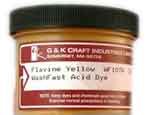ADVERTISEMENTS

Karren Brito's
Shibori: Creating Color and Texture on Silk
This book describes the use of Washfast Acid Dyes and Lanaset Dyes to dye silk using ancient Japanese Shibori tying techniques.
You are here: Home > All About Hand Dyeing > About Dyes > Dyes for Protein Fibers
ADVERTISEMENTS

ADVERTISEMENTS





Proteins are made out of different combinations of the twenty essential amino acids. They are more complex than cellulose, which is made out of repeating units of a sugar, glucose, and thus there are more ways in which different dye chemicals can attach to them. There are, therefore, many more different substances which can be used to dye protein fibers.
Silk is less sensitive to high pH than animal hair fibers are. This makes it the most versatile of all fibers for dyeing. It can actually be dyed quite well with the same soda ash recipe used to dye cellulose fibers with fiber reactive dyes. Silk can also be dyed with the acid dyes that are used for wool, or with the inexpensive but poorly washfast direct dyes that are often used on cotton. In fact, you can dye silk with just about any kind of dye, except for disperse dyes, which are designed solely for dyeing synthetic fibers.
Since silk can be dyed with almost any sort of dye, you need to decide which properties are most valuable for you in your current project. Are you most concerned that the dye be completely non-toxic for small children, or that it be particularly easy to apply, or that the dyeing process not alter the texture or luster of your silk even a little?
Non-toxic. Most of the dyes mentioned on this web site are not significantly toxic, but they are not safe to eat, either. If you want to use a dye that's safe to use your good (non-aluminum) cooking pots for, and still be able to use your dye-pots for food, then you should use food coloring. Food coloring is not the brightest, most predictable, wash-resistant, or fade-resistant of dyes. However, it is safe to use in your good cooking pots, and it is safe to use with small children, children who are too young to follow standard safety practices. If you'd like to use food coloring to dye silk, see the page Using Food Coloring as a Textile Dye for Protein Fibers.
No heating and no steaming. If your primary concern is to avoid investing right now in a dyepot, or to avoid bothering with simmering or steaming your dyes, then you should use a cool-water fiber reactive dye, such as Procion MX type dye. You can dye any washable silk with the same soda ash recipe we use for dyeing cotton with Procion MX dyes. It's perfect for tie dyeing, batik, low water immersion dyeing, dye painting, or any other form of direct dye application. It can also be used to dye silk in the washing machine. The only drawback is that the soda ash will make the silk a little less shiny and a little softer; sometimes this is desirable, but if your number one priority is to maintain the stiff texture and shiny luster of your silk, then you should use some sort of acid dyes, instead, although they will require some heating.
Alternatively, there is a way to fix Jacquard Green Label Silk colors at room temperature without the use of a high pH; these dyes are mixed to have an acidic (low) pH, although they are Remazol fiber reactive dyes.
A third alternative, if you do not want to steam your silk, is to use fabric paints or even fabric markers, instead of true dyes.
Wash-proofness. The best dyes for staying bright even after washing are the cold-water fiber reactive dyes, such as Procion MX, when used with soda ash, and the Lanaset dyes when used as directed. The metal complex dyes, such as KraftKolour's Premetallised Acid Dyes, are also very good. (In fact, some of the Lanaset dyes are metal complex dyes.) If you want an extremely long-lasting, wash-proof dye that does not make your silk a little softer, use Lanaset or metal complex dyes, both of which must be used either in a boiling dyebath or with steam-setting afterwards.
Good for silk painting. Any of the dyes mentioned above, with the exception of the food colorings, are good for silk painting, but you will have to mix your own colors. Procion MX dyes should be used within a week of mixing, but the other dyes stay good in water for up to a year, or in some cases longer.
The silk dyes known collectively as the French Dyes are available pre-mixed in a wide variety of colors in small jars. They are known for their brilliant colors as compared to the pigment-based fabric paints that are used in silk painting. Some of the colors are basic dyes (with poor lightfastness), some are reactive dyes, some are acid dyes, and some are metal complex acid dyes. The different brands of the French dyes include Dupont, Pebeo Soie, Sennelier Tinfix, and Kniazeff. They require lengthy steaming to fix them, three hours instead of the thirty minutes required for Remazol and Procion H dyes.
The Remazol dyes are very cost-effective when used as silk paints; you can set them after they dry by steaming the silk for half an hour. Both Remazol and Procion H dyes are considered to be less toxic alternatives to the French dyes, though it is impossible to do a direct comparison since in most cases there is no way to find out which dyes are included in the French silk dyes.
As with any fiber, for smooth, even solid colors, you need to immerse the silk fabric or yarn in a dyebath that is large enough for it to move freely. Cool water dyes, such as Procion MX, may be applied to silk fabric in a bucket or in a washing machine (preferably a top loader). Acid dyes and hot water fiber reactive dyes should be applied in a very large non-aluminum cooking pot, large enough for the silk to move in freely.
High pH for reactive dyes. Cool water reactive dyes such as Procion MX dye can be fixed at room temperature, without steaming, with any of several high pH chemicals. You can pre-soak the silk in soda ash before painting (optionally letting it line-dry), or add the soda ash to the dye immediately before use, or paint on a sodium silicate (After-Fix) solution afterwards. See What is soda ash, and what's it for in dyeing? for more information on soda ash and its substitutes.
Steaming is used to fix all acid dyes on silk, and also to fix hot water fiber reactive dyes such as Procion H, Remazol, and Drimarene X. In most cases, the dyed fabric is allowed to dry, then wrapped in layers of blank newsprint paper for steaming. A few recipes call for wrapping the dyed material in plastic wrap, but in these cases the fabric must be quite wet, because moisture is essential for either acid dyes or reactive dyes to bond to the fiber. True dyes cannot bond to silk without the presence of water in one form or another.
Note that steam cleaners, steam irons, and clothing steamers do not produce enough steam to set silk dyes.
Fixing Silk Dye in Hot Water. Hot water dyes, including both acid dyes and hot water fiber reactive dyes, can, instead of steaming, be applied by immersing the fiber to be dyed in a hot dyebath, usually for half an hour or an hour, along with any required auxiliary chemicals. The required temperature and timing will vary according to the specific type of dye.
Using Fixatives Instead of Heat. There are some chemical fixatives which can be used for acid dyes instead of steaming. The colors are likely to be less intense without steaming, but the method is convenient, especially for use in the classroom. (An equally valid approach, when steaming is impractical, is to use fabric paints instead of dyes.)
Jacquard's Green Label Silk Colors are Remazol dyes with added chemicals to make them suitable for fixing with Jacquard's Permanent Dyeset Concentrate, which is applied after the dyes are painted on. There used to be a similar product for acid dyes, called Tinfix Design Dye Fixative, but I can't find a source for it now. Dharma Trading Company advises that Jacquard's Permanent Dyeset Concentrate can be used with Tinfix dyes, though, they note, the colors will not be as brilliant as steam-set Tinfix dyes.
Other products that are called dye fixatives, such as Retayne, Dharma Dye Fixative, and iDye Fixative, are not suitable for use as an alternative for steam-setting dyes; these cationic dye fixatives are an entirely different sort of product, to be used only on dyes that have been properly set and yet which still lack adequate washfastness, such as direct dyes, all-purpose dyes, and acid leveling dyes.
Silk that has been dyed with Procion MX dyes using the soda ash recipe can be washed at any temperature without risk of running or bleeding dye, assuming that excess unattached dye was washed out after dyeing. Silk that has been dyed with Lanaset dyes, including some metal complex dyes in that line, is similarly washfast, and can be washed even in hot water, up to 140°F (60°C) without loss of dye. With these highly washfast dyes, the only limiting factor is the need to treat the silk gently enough that it does not wear out quickly.
However, silk that has been dyed with less washfast dyes, particularly acid leveling dyes and, especially, food coloring, should be carefully washed separately, in cool water only, to avoid causing the dyes to wash out. Silk dyed with food coloring should be washed as infrequently as possible, as the dye tends to wash out over time.
Many silk painters mark their work "dry clean only", to encourage the dye colors to stay bright as long as possible, and reduce wear on the material itself.
If at all possible, store dyed and painted silk out of direct sunlight or bright light. All dyes can be damaged by exposure to sun, and the French dyes used for silk painting have a particular reputation for poor lightfastness.
All of the pages on this site are copyright ©1998‑2025 Paula E. Burch, Ph.D.
Last updated: February 3, 2010
Page created: October 30, 2009
Downloaded: Wednesday, April 02, 2025
Some of the material ion this page originally appeared on another page on this site, Dyes for Protein Fibers, which was first created on May 5, 2003.